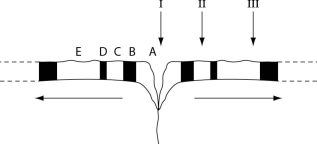The following questions refer to the description and Figure 23.1.
Figure 23.1 represents a cross section of the sea floor through a mid-ocean rift valley, with alternating patches of black and white indicating sea floor with reversed magnetic polarities. At the arrow labeled "I" (the rift valley) , the igneous rock of the sea floor is so young that it can be accurately dated using carbon-14 dating. At the arrow labeled "III," however, the igneous rock is about 1 million years old, and potassium-40 dating is typically used to date such rocks. Note: The horizontal arrows indicate the direction of sea-floor spreading, away from the rift valley.
 Figure 23.1
Figure 23.1
-Assuming that the rate of sea-floor spreading was constant during the 1-million-year period depicted in Figure 23.1, on average Earth's magnetic field has undergone reversal once every
A) 10,000 years.
B) 25,000 years.
C) 100,000 years.
D) 250,000 years.
E) 1,000,000 years.
Correct Answer:
Verified
Q1: Which measurement(s)would help determine absolute dates by
Q2: If a fossil is encased in a
Q6: If the half-life of carbon-14 is about
Q6: Larval flies (maggots) express the Ubx gene
Q7: The evolution of mammals from early tetrapods
A)
Q22: The loss of ventral spines by modern
Q27: Fossil evidence indicates that several kinds of
Q36: Many species of snakes lay eggs. However,
Q37: The major evolutionary episode corresponding most closely
Q40: Bagworm moth caterpillars feed on evergreens and
Unlock this Answer For Free Now!
View this answer and more for free by performing one of the following actions

Scan the QR code to install the App and get 2 free unlocks

Unlock quizzes for free by uploading documents